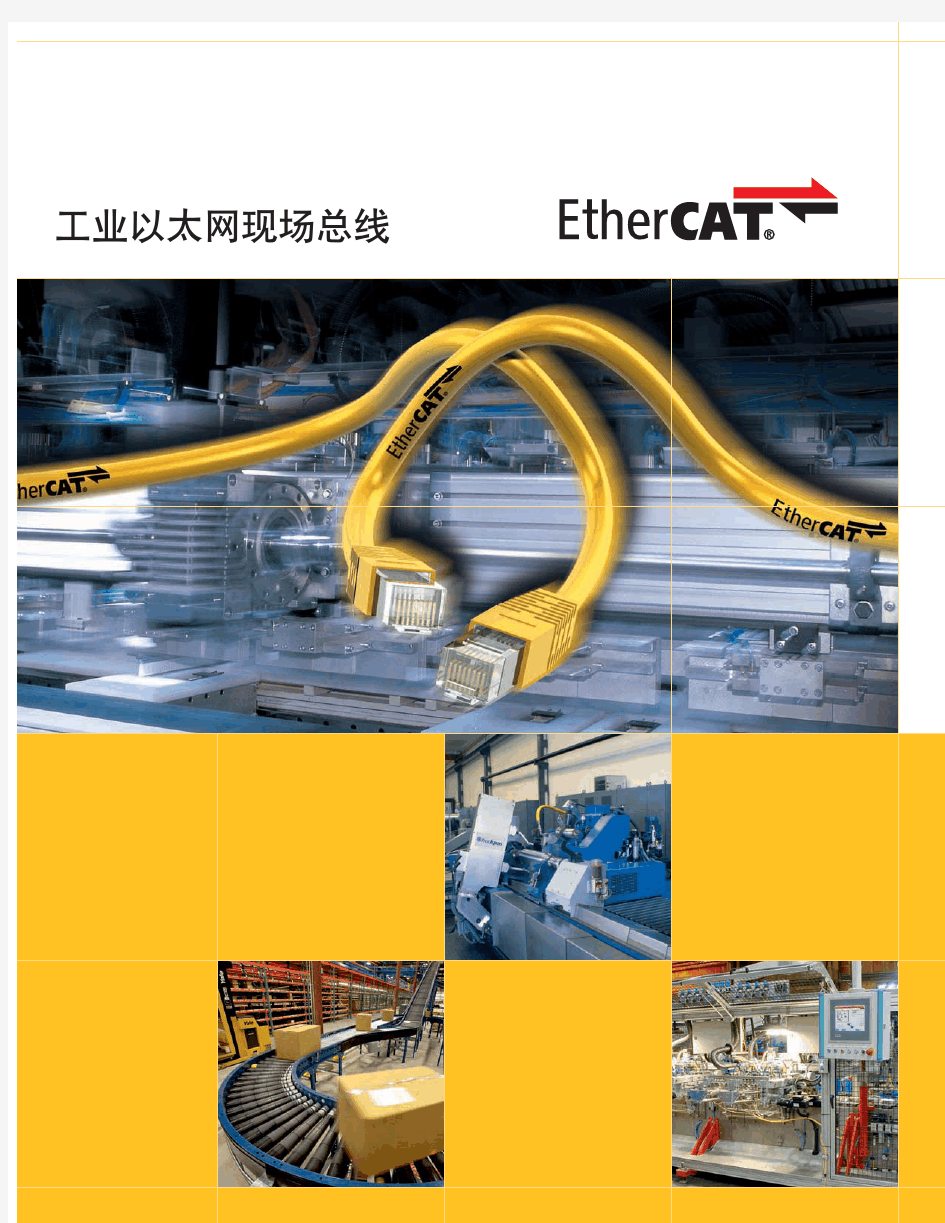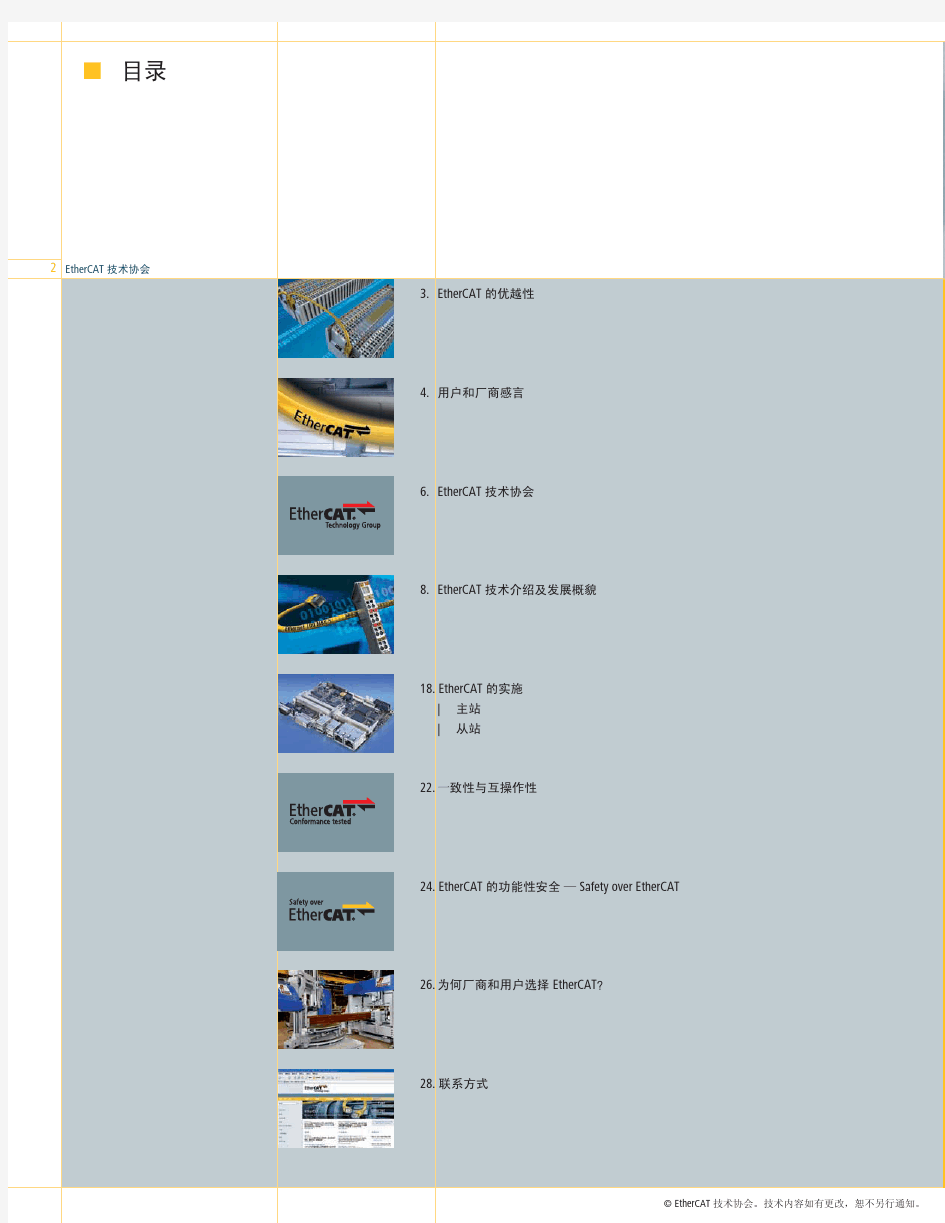

?EtherCAT??? 3
EtherCAT ?
? EtherCAT ?? ? ? ????
? ??ぎ? ? ? ? ? ?
āEtherCAT ? ?催?? ? ? ?? ???? ? ?? ?EtherCAT ? ? ?? ??? ? ??П?? ? ? ?? ? ?? ??催 ? ?
? ??? ? ?? ? ?? ????? ? ??
???? ? ? ?ā
? ? ?? ? ?? ? ??
āEtherCAT 催 ???? ? ?? ?? ??催 ?? ??? ?? ? ? ?? ??? ? ?催???? ?? ??? ? ??? ? ?? ?Ether-CAT ? ?? ?? ?? ?? ?? TCP/IP ㄝ ? ? ? ? ???? ???? ? ?? ?? ???? ?? ?? EtherCAT Ё ?? ?? ? ? Ё ? ??ā
? Ё ???? ? ?? ? ? ??????? ??
āEtherCAT ? ????? ??Ё催? ??????EtherCAT ?? ? ?? ?????〇 ??? ? ? ? ? PC ? ? ??? ? EtherCAT ??? ?
? ? ? EtherCAT ?キ??? ?????? ?? ??? ? ?? ???? ? ?? EtherCAT ?キ??? ?? ? ?? ??キ ??? ?ā
? ? ? ??お ? ?? ??
ā ? ? ?? Ё?? 偅 П???? ????????? ?? ???? ?? ? ?? ??? ?催? ?催??? ? ? ? ?
?????? ? ????EtherCAT ????? ?? ?????催??? ? ? ? ? ?佪 ? ??? ????? ???キ?? ?? ???? ? ???? ? ? ? ? ? ? Н???? ? ? ? ????? ? ? ?????? ?? ? ?? г????キ ? ??? ?? ???? ? ? ? ?? ??? ??? ??? ?? ? ?? ?? ? ? ?? ?ā
? Beckhoff ? ? ?? ? ??Hans Beckhoff ??
ā ??EtherCAT ? ? ? PC ?催? ??キ ? ? ???? ? ? ??? ?? ? ?????? ?EtherCAT ?? ? Ё ???
? ?? ? ?? ?EtherCAT г B eckhoff ?? ?偼 ????? ? ?? 催 ?乍 ? ? ?ā
? ? 乎 ?? ?おЁ ? ???Ё ? ??? ?お ?お ?? ?
āEtherCAT ? ?? ?Ё ? ? ?? ?? PLC ?? ?? ? ? 偅 ?ㄝ ?? ? 催? ?有 ? ?
? ??? ?? ? EtherCAT ??? ?? ? ? ??? ?? ? ? Ё ?? ??? ? ??EtherCAT ? ???? ? ?? ??? ?? ??? ?? 催?? ? ? ? ? ? ? ?? ?? ?? ???? ? 催? ????? ? ???? ? ?? ? EtherCAT ? ?? ? ?EtherCAT ? ? ? ????? ?ㄝ?? ? Ё ? ??? ? г ?Ё ??? ?????ā
5
EtherCAT ?
ETG-Team
? 10?EtherCAT ? ??
?キ
Hilscher ???キ?? ?
电气与自动化工程学院 《控制网络与通信》 期末大作业报告 题目:工业以太网EtherCAT 协议分析与研究 姓名:吉宇 学号:160514205 班级:测控142 学年:2016~2017学年第二学期
目录 1.引言 (1) 1.1选题意义及课题来源 (1) 1.2国内外研究和发展现状 (1) 2.主流工业以太网技术对比 (2) 2.1工业以太网概述 (2) 2.2实时工业以太网的比较 (2) 3.ETHERCAT系统运行原理 (3) 3.1E THER CAT系统组成 (3) 3.2E THER CAT数据帧 (4) 3.3E THER CAT寻址方式和通信服务 (5) 3.4应用层 (5) 4.应用案例 (6) 5.结束语 (8) 参考文献 (9)
1.引言 1.1选题意义及课题来源 在 Internet等信息网络技术飞速应用的时代,工业上提出了一种重要的方案来解决工业现场设备和设备系统之间的信息集成,这就是现场总线。由于现场总线经济实用、可靠、简单,所以得到了许多工业化企业、标准团体等的密切关注,得到了非常广泛的研究和应用。 然而在其不断的发展过程和实际应用中,一些不好之处逐渐显现:如标准过多,相互之间又不可兼容,信息不能全面连接集成,传输速率较低,并且在工业上使用的现在现场总线需配备单独的实时网络,使用的成本也比较高。基于以上不足,工业化企业因此逐渐将发展目光转向了具有管理方便、兼容性好、传输速度快、开放性强、结构简单、功耗低和成本低等优点的以太网。 1.2国内外研究和发展现状 目前,国内外已经开发出了多种工业以太网产品,如 Profi Net、Powerlink、Modbus/TCP、Ethernet/IP、EtherCAT、EPA等。在众多工业以太网协议中,EtherCAT凭借它的卓越的实时性优势、拓扑结构灵活、配置简单、易于实现、基于以太网标准及技术的开放性等优势,已经逐渐成为工业控制领域发展的主流。 国外很多企业对EtherCAT的技术研究已经比较深入,而且已经开发出了比较成熟的产品,除了德国Beckhoff之外,还有美国Kollmorgen、意大利Phase、美国 NI、SEW、TrioMotion、MKS、Omron、Copley Controls 等自动化设备公司都推出了一系列支持 EtherCAT驱动设备。 1.3主要内容及章节安排 第一节为引言。本章主要介绍本文的选题意义和针对课题研究背景做简单介绍,概述了国内外研究和发展现状与对本文的主要内容进行安排。 第二节为工业以太网技术对比。通过对几种主流的实时工业以太网进行对比分析,得出EtherCAT协议的优势。 第三节为EtherCAT运行原理。对EtherCAT协议相关的理论知识进行介绍,包括系统主从站组成、EherCAT协议帧、EtherCAT报文寻址方式及通信命令、协
EtherCAT协议是德国倍福自动化有限公司(Beckhoff Automation GmbH)于2003年提出,并于2005年被定为IEC标准62407;2007年,IEC把EtherCAT协议加到工业现场总线标准61158。 一、协议概述 为提高通信效率以及实时性,EtherCAT协议的主要思想有两方面。简化协议,协议兼容以太网的MAC层协议,并由纯硬件完成解析,提高处理速度;而其他协议由软件解析上层协议,由于CPU的负载在不同时段的不确定性导致相应的处理时间偏差加大,而纯硬件的方式能在确定的时间内完成处理,使时间更加精确。EtherCAT协议考虑到工业应用中每次通信的数据量小和对实时性要求高的特点,在以太网数据包的基础上加入自己的协议,把一个以太网数据包分成若干个EtherCAT数据包加以充分利用,并给主站控制各从站提供了更大的灵活性。 EtherCAT网络由一个主站(Master)和最大可能为216次个从站(Slave)组成,支持以太网的所有拓扑结构(星型/总线型/环型等),其工作原理如下:EtherCAT网络就像是一列运行的火车,主站是火车的起点和终点,火车把车上的乘客(数据包)送(写操作)到任何指定的站点(从站),也能在所有它经过的站点上接收新的乘客(读操作),它是工业领域中飞速传输的以太网。 二、EtherCAT关键技术 1.帧结构 EtherCAT在以太网帧结构的基础上加入了新的协议,数据的最外层是以太网数据帧。在以太网数据帧的数据部分中实现EtherCAT协议,由EtherCAT协议头开始,后跟若干个数据包。数据包由包头和数据组成,最后跟WKC以判断每次操作是否正确。 2.寻址方式 EtherCAT主站通过特定的寻址方式选择从站,当整个EtherCAT网络中有路由器时,主站先通过网段间寻址(segment addressing)找到子网,网段寻址通过以太网数据帧中的目标地址(Destination Address)找到目标网段,而这个DA是目标网段内第一个EtherCAT 从站的MAC地址。当EtherCAT数据包经过第一个子网络后,从站把DA和SA(Source Address)互换,因为数据经过全部从站后,要返回到主站。 EtherCAT网段内寻址包括设备寻址(Device addressing)和逻辑寻址(Logical addressing),设备寻址分两种寻址方式,位置寻址(position addressing)和节点寻址(Node addressing)。位置寻址的地址由从站在网段中的位置决定,一般上电后主站通过位置寻址统计网段内的从站总数;节点寻址通过给每个从站配一个各不相同的节点地址,主站通过节点地址选择从站。逻辑寻址由主站发一个32位的逻辑地址,从站通过现场总线内存管理单元(FMMU)的配置确定是否被选中以及要访问的从站内的寄存器地址,这种寻址方式最灵活,在一个数据包管理多个从站的应用中作用明显。 3.FMMU FMMU(FieldBus Memory Management Unit)类似CPU中的MMU,系统上电后通过EEPROM 或主站对每个从站的FMMU(每个从站最多16个FMMU条目)配置逻辑地址和物理地址的映射关系,每个条目包含一对映射关系。主站发出32位逻辑地址,从站查找FMMU的条目,如果某一个条目中的逻辑地址与接收到的逻辑地址相等,且当前条目的配置有效,则当前从站被选中。 4.SyncManager EtherCAT从站的同步管理单元(SyncManager)用于同步主站和从站间的数据操作,它可以把从站中的操作对象(寄存器和存储单元)配置成实时操作的buffer模式和握手方式的
EtherCAT Protocol Implementation Issues on an Embedded Linux Platform Sorin Potra LVD-Napomar Bd-ul Muncii, nr. 14, Cluj-Napoca, Romania Sorin.Potra@lvdnapomar.ro Gheorghe Sebestyen Technical University of Cluj-Napoca G. Bari?iu, Nr. 26-28, Cluj-Napoca, Romania Gheorghe.Sebestyen@cs.utcluj.ro Abstract – The paper presents the most important implementation issues of an industrial communication protocol, the EtherCat protocol, on an embedded Linux platform. The authors underscore critical aspects (e.g. reliability, timeliness, predictability) concerning the use of an Ethernet-like protocol in an industrial environment. I.I NTRODUCTION Today, the use of industrial communication networks is mandatory in most automation systems [8]. Industrial protocols are specially designed to fulfill the specific communication requirements of control applications, such as: real-time data delivery, high reliability and dependability, priority-based messaging, etc. [6][7]. An industrial network assures the communication environment between different automation devices, from the simplest ones, like intelligent sensors and actuators, until the more complex, process computers. Figure 1 shows a hierarchical automation system where industrial networks are the links between the system's components (sensors – S, actuators – A, Programmable Logic controllers – PLC, and industrial PCs). The implementation of an industrial protocol involves a number of issues [6]: -the protocol must be developed on systems (e.g. intelligent sensors or actuators) with limited hardware and software resources; such limitations are: small memory capacity, limited processor speed, few or no operating system support -time restrictions and message delivery deadlines must be guaranteed Figure 1. A network-based automation system -the roundtrip time of a request-answer message pair is much smaller (usually microseconds) than in the case of usual networks; -the protocol drivers must have a highly predictable behavior; for instance, uncontrolled delays caused by message queues are not allowed -automatic fault recovery mechanisms must be included in the protocol drivers The following chapters present the way in which these issues were solved during the implementation of an industrial protocol, namely the EtherCAT. II.B RIF DESCRIPTION OF THE E THER CAT P ROTOCOL In the last decade there were a number of attempts to adapt general-purpose computer protocols (e.g. Ethernet, TCP/IP) [4][5] for industrial purposes. EtherCAT (Ethernet Control Automation Technology) is a relatively new industrial protocol built on the Ethernet specifications; it incorporates some new features that make it adequate for control applications. This protocol solves the compatibility gap between an industrial protocol and a computer network protocol. The EtherCAT combines the efficient and relatively high-speed message transmission (specific for Ethernet networks), with the predictability imposed by a master/slave medium access control policy. This access policy works in the following way: there is a single master node on a network segment that has the right to initiate data transfers; this node sends an Ethernet frame to the slave nodes; a slave node extracts the data from the frame addressed to it, puts some new data in the frame and than sends the frame to the next slave; the frame arrives back to the master node confirming the correctness of the transmission. All the message reception, data processing and frame retransmission operations are made "on the fly" by the slave nodes, without any extra delays. Special hardware components, embedded in the slave's Ethernet interface, are responsible for these operations. This solution assures a minimum roundtrip (reaction time), better than in the case of other industrial protocols (e.g. CAN, Profibus, etc.). Figure 2 shows a typical EtherCAT segment, with one master node (a data acquisition, control and supervision device) and a number of slave nodes (intelligent sensors and actuators, PLCs, etc.). 1-4244-0361-8/06/$20.00 ?2006 IEEE